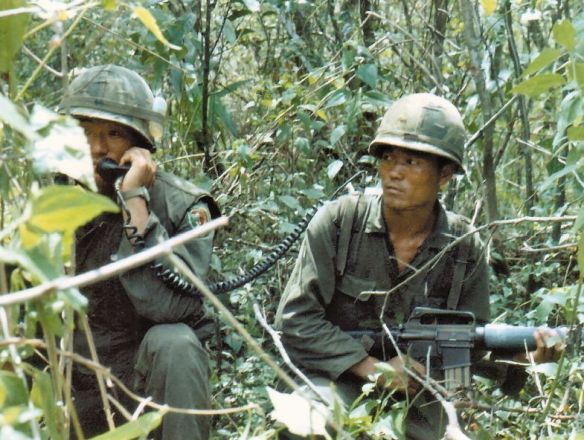A squad leader of the ROK Tiger Division keeps in contact with his men during an operation in the Central Highlands.
As early as 1954 Korea had offered to send a Korean Army element to Vietnam but the offer was turned down. Ten years later a Survey (Liaison) Team arrived in August 1964 to give asssistance with civic action programs while discussions about Korea’s future involvement took place.
Its first contribution was the Republic of Korea Military Assistance Group, which arrived at Bien Hoa in February 1965 and started work on civic action projects, helping in areas affected by heavy flooding during recent monsoons. The force, nicknamed the Dove Unit, numbered over 2,400 and it was organized as follows:
Construction support group
Marine Corps engineer company
Navy landing craft
Korean Army security company
Troops worked on bridges, schools and dispensaries and while operating under special rules of engagement that only allowed them to return fire, they relied on the ARVN for assistance if they came under sustained attack.
Following high-level talks between President Johnson and President Park in May 1965 the decision was taken to deploy the equivalent of a division, supported by an F-86 fighter squadron. However, there were conditions. The Korean government announced that its troops must be under US control as a separate and distinct force as a matter of pride. Although they wanted to display support for a neighboring country they did not want Korean soldiers acting like paid mercenaries; they had to be operating independently under US military control. They also wanted full US logistical support and a large amount of financial aid.
Military Assistance Command, Vietnam, wanted to prevent competitiveness between Korean and South Vietnamese units and it chose the coastal areas surrounding their logistics bases for their deployment. The Capital Division, known as the Tigers, began to arrive in the area west of Qui Nhon in September 1965 and over the next six months it helped to take control of Binh Dinh Province.
CAPITAL DIVISION
Headquarters and Headquarters Company
Cavalry Regiment, 1st and 26th Infantry Regiments, each with three battalions
Headquarters and Headquarters Battery, Artillery Division
10th, 60th and 61st 105mm Field Artillery Battalions
628th 155mm Field Artillery Battalion
Armor Company, Reconnaissance Company and Aviation Section
Combat support was supplied by an engineer battalion, a signal company and a military police company. Support and Service troops included a medical company, an ordnance company and a quartermaster company.
The 2d Marine Corps Brigade, known as the Blue Dragons, deployed at the same time around Cam Rahn Bay but it soon had to move to secure the Tuy Hoa area. In August 1966 it moved to the Bong Son area, north of Qui Nhon.
2D MARINE CORPS BRIGADE
1st, 2d and 3d Battalions; 5th Battalion joined in 1967
9th (White Horse) Infantry Division deployed along II Corps’ southern coast in September 1966 where it took over responsibility for the area around Cam Rahn Bay, Tuy Hoa and Ninh Hoa.
9TH INFANTRY DIVISION
Headquarters and Headquarters Company
28th Regiment, 29th and 30th Infantry Regiments, each with three battalions
Headquarters and Headquarters Battery, Artillery Division
30th, 51st and 52d 105mm Field Artillery Battalions
966th 155mm Field Artillery Battalion
It had the same combat support and service troops as the Capital Division.
The arrival of this second division brought the strength of the Korean forces in Vietnam to around 45,000, and the Republic of Korea Military Assistance Group was increased in size so it could operate as a corps headquarters. It was based in Nha Trang and reported to II Field Force while working alongside II Corps.
2d Marine Brigade left Vietnam between December 1971 and February 1972. The rest of the Korean troops were some of the last to withdraw, leaving the country during the first three months of 1973.
ROK Army and Marines prove to be rock-solid fighters and allies in Vietnam War.
